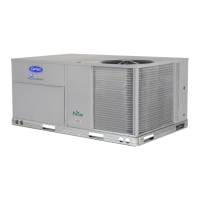20
Fig. 26 — Condensate Drain Piping Details
All units must have an external trap for condensate drainage.
Install a trap at least 4-in. (102 mm) deep and protect against
freeze-up. If drain line is installed downstream from the exter-
nal trap, pitch the line away from the unit at 1-in. per 10 ft
(25 mm in 3 m) of run. Do not use a pipe size smaller than the
unit connection (
3
/
4
-in.).
Step 12 — Make Electrical Connections
NOTE: Field-supplied wiring shall conform with the limitations
of minimum 63°F (3°C) rise.
FIELD POWER SUPPLY
If equipped with optional Powered Convenience Outlet: The
power source leads to the convenience outlet’s transformer pri-
mary are not factory connected. Installer must connect these
leads according to required operation of the convenience out-
let. If an always-energized convenience outlet operation is de-
sired, connect the source leads to the line side of the unit-
mounted disconnect. (Check with local codes to ensure this
method is acceptable in your area.) If a de-energize via unit
disconnect switch operation of the convenience outlet is de-
sired, connect the source leads to the load side of the unit dis-
connect. On a unit without a unit-mounted disconnect, connect
the source leads to compressor contactor C and indoor fan con-
tactor IFC pressure lugs with unit field power leads (see
Fig. 27).
Fig. 27 — Power Wiring Connections
Field power wires will be connected line-side pressure lugs on
the power terminal block or at factory-installed option non-
fused disconnect or HACR circuit breaker.
Field power wires are connected to the unit at line-side pres-
sure lugs on compressor contactor C and indoor fan contactor
IFC (see wiring diagram label for control box component ar-
rangement), at factory-installed option non-fused disconnect
switch or HACR circuit breaker. Max wire size is #4 AWG
(copper only) per pole on contactors and #2ga AWG (copper
only) per pole on optional non-fused disconnect or HACR cir-
cuit breaker. See Fig. 27 and the unit label diagram for field
power wiring connections.
NOTE: TEST LEADS — Unit may be equipped with short
leads (pigtails) on the field line connection points on contactor
C or optional disconnect switch. These leads are for factory
run-test purposes only; remove and discard before connecting
field power wires to unit connection points. Make field power
connections directly to line connection pressure lugs only.
WARNING
ELECTRICAL SHOCK HAZARD
Failure to follow this warning could result in personal
injury or death.
Do not use gas piping as an electrical ground. Unit cabi-
net must have an uninterrupted, unbroken electrical
ground to minimize the possibility of personal injury if
an electrical fault should occur. This ground may consist
of electrical wire connected to unit ground lug in control
compartment, or conduit approved for electrical ground
when installed in accordance with NEC (National Elec-
trical Code); ANSI/NFPA 70, latest edition (in Canada,
Canadian Electrical Code CSA [Canadian Standards As-
sociation] C22.1), and local electrical codes.
NOTE: Trap should be deep enough to offset maximum unit static
difference. A 4-in. (102 mm) trap is recommended.
MINIMUM PITCH
1˝ (25 mm) PER
10´ (3 m) OF LINE
BASE RAIL
OPEN
VENT
TO ROOF
DRAIN
DRAIN PLUG
ROOF
CURB
SEE NOTE
3˝ (76 mm)
MIN
WARNING
FIRE HAZARD
Failure to follow this warning could result in personal
injury, death, or property damage.
Do not connect aluminum wire between disconnect
switch and air conditioning unit. Use only copper wire.
(See Fig. 28.)
Disconnect
per
NEC
11 13 13
L1 L2 L3
CIFC
208/230-3-60
460-3-60
575-3-60
Units Without Disconnect or HACR Option
Units With Disconnect or HACR Option
L1
L2
L3
2
4
6
1
5
Optional
Disconnect
Switch
Disconnect factory test leads; discard.
Factory
Wiring
3
Ground
(GR)
Equip
GR Lug
Equip GR Lug
Ground
(GR)

